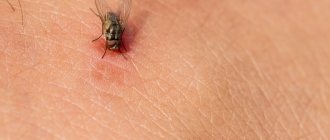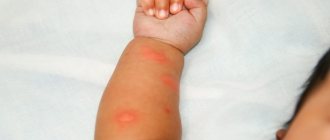If spots appear on the skin from sweat on a person’s body, it means that he has some kind of disturbance in the functioning of some body systems. Red spots can appear in different places on the patient’s body and have different shapes and sizes. They can serve as the main symptom in diagnosing a particular disease.
The main factors in the appearance of spots on the skin from sweat can be various pathological conditions that lead to disturbances in metabolic and other processes in the human body and require immediate treatment.
Such conditions are very often detected in people who are unaware of the disease developing in their body, and are confident that the spots can be eliminated with some kind of deodorant or ointment. Below we will discuss several reasons that can lead to the formation of sweat stains on the skin.
The influence of stress on the development of the disease
If a person is exposed to various stressful situations at work and at home, both physical and psychological in nature, then he may develop so-called vegetative-vascular dystonia. Such a violation of tone in the functioning of the nervous system also occurs during strong experiences. At the same time, the parasympathetic and sympathetic vascular tone begins to change significantly. After the corresponding development of the disease, many people develop red rashes in the form of spots of various shapes on the skin, which can remain on the patient’s skin for a long time.
To prevent this group of diseases, doctors recommend that the patient avoid various stressful situations, switch to a balanced diet, and get more rest. To strengthen vascular tone, various medications are used over a long period. After this, a course of rehabilitation may be required, which doctors offer to the sick person.
Causes and symptoms of allergies
Many different factors can cause an allergic reaction - food, household chemicals, animal hair and pollen, fabrics, medications and even ultraviolet radiation. Sometimes even this knowledge is enough to distinguish allergies from prickly heat. If you've recently made changes to your usual diet, started taking new medications, or changed brands of laundry detergent, these factors are likely to be the cause of your breakouts. However, allergies can also arise unexpectedly - for example, if you have never previously noticed a negative reaction of the body to dog hair, and have only recently encountered this problem. In this case, special tests can help - they will not only help establish the presence of an atypical reaction to certain irritants, but will also help identify a specific allergen.
Usually, to get rid of the symptoms of prickly heat, it is enough to eliminate the factors that cause waterlogging and contamination of the skin - most often this is a lack of hygiene, poor ventilation of the skin due to clothing, or staying in hot and poorly ventilated rooms. In most cases, symptoms quickly disappear after this. An allergic rash is much more persistent: it is difficult to treat and does not always go away even after eliminating contact with the allergen.
Allergic reaction of the body to various lesions
Red rashes may indicate the development of an allergy. Such formations are found in various allergic conditions, for example, urticaria, delayed reaction, cold allergy. With such manifestations, doctors need to not only pay attention to the appearance of the rash, but also examine other symptoms that may appear in the patient. This can be caused by various chemicals or natural allergens. In case of urticaria and cold-type allergies, it is necessary to urgently provide the patient with medical assistance. If this is not done, the disease may worsen, which will lead to the need for long-term treatment of the affected person.
Allergic types of disease also include chronic diseases such as eczema and atopic dermatitis. They develop in the form of a delayed allergic reaction, which occurs due to the penetration of various allergens of natural or artificial origin into the patient’s body. This usually occurs when ingesting food or introducing these substances through the skin. This significantly worsens the patient’s condition: a red rash consisting of large-sized elements begins to appear. Their appearance brings additional suffering to a person: he begins to experience unbearable itching, which leads to scratching of the skin. This predisposes to infection by various microbes, which will aggravate the patient’s condition.
Immunoglobulin E is to blame for everything
Like any other allergic hypersensitivity, this type of pathology is accompanied by an increase in the concentration of class E immunoglobulins (IgE) in the patient’s blood, which have a detrimental effect on the body’s mast and basophilic immune cells.
When these cells are destroyed, an aggressive substance is released - the mediator of inflammation and allergies, histamine. In the case of an allergy to one’s own biological substances, this mechanism is triggered in response to the production of a certain organismal factor: tears, sweat, sperm, etc.
It is important to understand that this type of allergy is no less dangerous than any other and requires treatment from an allergist.
Red rash on the skin due to infectious lesions
This phenomenon can be caused by various diseases that appear when viruses, bacteria, and fungi invade various human organs. The location of the rash elements, their size and shape allow doctors to identify the causative agent of the infection and carry out the appropriate course of therapy. For viral infections, a red rash is a sign of the following diseases:
- German measles.
- Measles.
- Chicken pox.
Typically, these diseases affect children who have not received preventive vaccinations against these infectious lesions. But adults can also get them if they are not immunized. However, their disease is more severe than that of young children. If a person falls ill with one of these diseases, then he must be urgently isolated so that an outbreak of any infection does not occur. Doctors must identify such a patient in time, examine him, and make an accurate diagnosis.
Each such lesion corresponds to a specific location and shape of the rash:
- During the development of measles, red elements appear on the face, then descend to the lower part of the body, resulting in pimples filled with fluid. They cannot be pierced or touched with your hands, as after a while they will disappear on their own.
- Rubella gives a rash, which becomes covered with a scaly crust on the third day. These elements are located mainly at the bends of the arms and legs, on the torso. When pressed, the rash disappears and then appears again.
- Chickenpox is characterized by red elements that transform into pustules and vesicles. They are usually located throughout the patient's body.
All these manifestations of the above diseases allow doctors to accurately diagnose them and take measures to combat them.
Bacterial and fungal infection in infectious diseases
A red rash can appear on a person's skin when bacteria and fungi invade the body. In the first type of infection, streptococci introduce infection into the patient's body. They provoke the occurrence of diseases such as scarlet fever, streptoderma, erysipelas of the skin. Each of these ailments has its own specific rash and specific location.
It appears along with other symptoms characteristic of these diseases. For example, with streptoderma, phlyctenes (red pimples that are filled with liquid) are formed. With tonsillitis and scarlet fever, a rash simultaneously appears on the patient’s skin throughout the body. Antibiotics are usually used to treat a bacterial infection.
Fungal infection of the skin can be manifested by the appearance of red elements on the surface of the patient’s body. Typically, these symptoms are characteristic of thrush, which is caused by the Candida fungus. This indicates the development of the disease and suppression of the immune system.
If a patient is infected with ringworm, then red pimples appear on his skin, which have a flaky surface and a round shape. They are usually located on the head under the hair, but as the infection develops, they can move to other parts of the patient’s body. Psoriasis is difficult to treat.
Human autoimmune diseases
A rash on the patient's body may indicate the onset of the development of diffuse connective tissue lesions, such as red gerbil or scleroderma. These diseases are caused by autoimmune lesions of the human body.
This phenomenon (the appearance of a red rash) occurs at the initial stages of the development of the pathology. Most doctors consider this symptom favorable for the patient, since it mainly means damage to the skin and its underlying surface (fiber). This limits the options for the development of the disease and allows you to successfully fight it.
If a patient is sick with lupus erythematosus, then after the appearance of the rash, peeling begins, and when affected by scleroderma, pimples appear in areas of scarring of the skin. With significant systemic damage to the body, a red rash appears on the skin of the patient when the autoimmune process is activated, which has passed into the chronic stage. Psoriasis can also be considered among the above ailments. Its nature is not fully clarified, but it has been revealed that it occurs when the immune system is damaged.
With this disease, pathological zones are located mainly on the skin of the patient, but when psoriasis is activated, damage to the nails, skin under the hair on the head, and joints may occur.
All considered cases of the appearance of red elements on a person’s skin from sweat must be identified in time and contacted at a medical institution, where they will conduct an examination and make an accurate diagnosis. After this, it is necessary to urgently begin treatment, which can last quite a long time. It all depends on the disease itself, its stage of development and the degree of damage to the patient’s body.
When your own people become strangers
In order to better understand the nature of such disorders, consider several unusual types of “biological allergies”:
Allergy to sweat.
Sweat is secreted through the sweat glands and is accompanied by the elimination of nitrogenous base breakdown products from the body. This allergy in medicine is called “cholinergic urticaria”, since the symptoms of the attack correspond to the classic signs of urticaria. A person who is allergic to his own sweat notices the appearance of pinkish-pale blisters and inflammation of the skin in places where sweat glands accumulate - on the face, neck, chest and armpits. These signs are accompanied by severe itching and pain in the affected area. Immunity pathologies, intense physical activity, frequent sauna visits, and wearing synthetic clothing can provoke an allergic reaction to sweat.
Allergy to tears.
Perhaps many people have noted the appearance of characteristic pink spots on the face, itching and burning of the mucous membranes of the eyes and inflammatory skin reactions while crying. If earlier doctors claimed that such a reaction occurs as a symptom of contact dermatitis, it has recently become clear that some components of tear fluid can actually provoke an increase in the concentration of IgE in the patient’s blood, and this indicates an allergy.
Allergy to hormones.
Just a few years ago, the vast majority of doctors argued that the molecules of hormonal substances are too small to cause the development of an allergic reaction. However, recent research has shown that this is not the case. Female sex hormones, in particular estrogen and progesterone, “work” especially actively in this regard. That is why officially confirmed cases of such an unusual allergy are observed only in women; the main symptoms are severe premenstrual syndrome and complicated menstruation.
Allergy to sperm.
One of the most unpleasant forms of biological allergies is the hypersensitivity of a woman or man’s body to sperm protein. If for a woman such a reaction can be explained by the protest of white blood cells against the introduction of foreign cells, then for men an allergy to their own sperm seems a strange phenomenon.
It is important to understand here that problems arise not when seminal fluid gets on the skin or mucous membranes, but when the patient’s blood mixes with sperm. The root cause of such rejection of one’s own germ cells is almost always trauma to the genital organs (testicles), and the consequences most often manifest themselves in the patient’s infertility.











